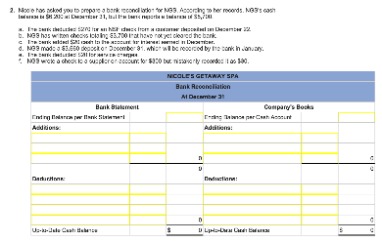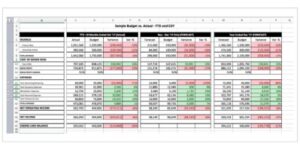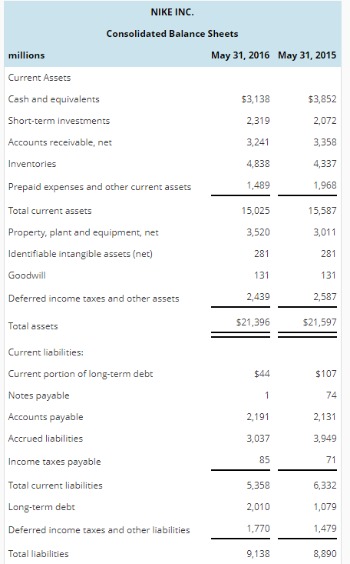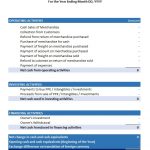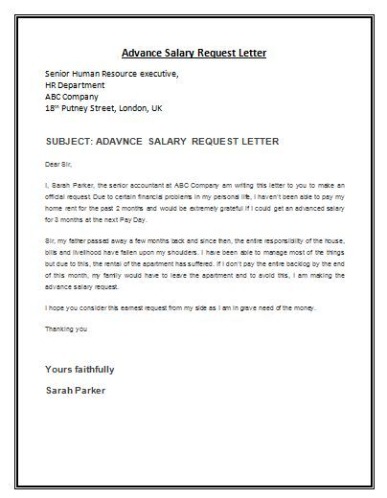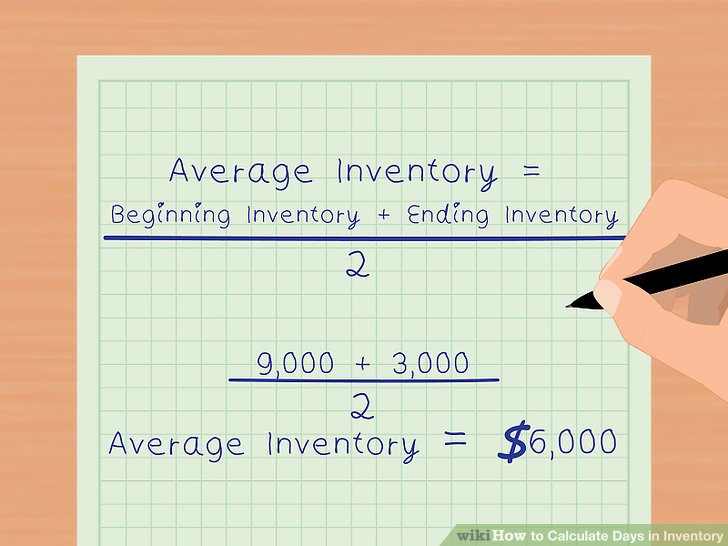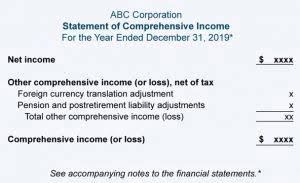
These standards, as set by each particular country’s accounting standards board, will in turn influence what becomes GAAP for each particular country. For example, in the United States, the Financial Accounting Standards Board makes up the rules and regulations which become GAAP. Interest paid and interest received must be categorized as operational activities under GAAP, however international rules are a little more lenient.
Financial StatementsFinancial statements are written reports prepared by a company’s management to present the company’s financial affairs over a given period . GAAP, and probably the most difficult standard to convert between the two, is revenue recognition. Revenue is considered earned when a transaction has taken place between two parties. GAAP framework, a company can only recognize revenue in the period it was earned, regardless of the time in which they actually receive the revenue. On the other hand, IFRS recognizes revenue in an unusual way.
The SEC is addressing this topic in order to find the right balance between the “educated” professional judgment, that is acceptable, and the “guessed” professional judgment. FREE INVESTMENT BANKING COURSELearn the foundation of Investment banking, financial modeling, valuations and more. IFRS offers several benefits over the Indian GAAP. IFRS improves transparency in accounting system, it is globally accepted, and also allows exercise of professional judgment.
Newly Added Differences
Investors and financial analysts must be sure they understand which set of standards a company is using, and how its bottom line or financial ratios will change if the accounting system were different. According to GAAP, accounts must be listed in order of liquidity, or how quickly and readily they may be converted to cash. So, current assets, non-current assets, current liabilities, non-current liabilities, and owners’ equity are listed in descending order .
GAAP and IFRS® Standards — two of the most widely used accounting standards in the world. Developed by the International Accounting Standards Board , IFRS is a set of accounting standards and rules that companies around the world use to prepare their financial statements. In conclusion, there are many constrictions in converting U.S. GAAP framework will completely change how companies report their financial results in the coming years. GAAP to IFRS will create the benefits of stronger comparability and consistency between U.S. and foreign corporations’ financial statements.
Ifrs
This extra information helps users better understand the extent of their company’s influence on the final numbers. The convergence of IFRS and GAAP to create a single set of accounting standards for worldwide use has been taking place, in some form, for decades. Efforts to reduce the differences between GAAP and IFRS are ongoing. However, we’re still some distance from the US Securities and Exchange Commission actually making the switch from GAAP to IFRS. Ultimately, IFRS vs. US GAAP is an issue that businesses will need to deal with for the foreseeable future.
- GAAP takes a more conservative approach and prohibits reversals of impairment losses for all types of assets.
- Development Cost is treated as an expense in GAAP, while in IFRS, the cost is capitalised provided the specified conditions are met.
- Hence, a company should be aware of all types of reporting standards that they may be required to follow.
- The principle of matching is when you record all related revenue and costs together.
- When it comes to research and development, under IFRS, research costs are expensed, whereas development costs are capitalized.
- IFRS is a global set of standards used by 15 of the G20 countries.
GAAP focuses on large complex economies that have less room for interpretation and provides a guideline approach to implementation. It is believed that if there are more rules and guidance, then a company does not need to disclose as much within their financial statements. GAAP should remain the «Gold Standard» because they believe that having a more rules based approach will reduce interpretation and will produce more transparent financial results. Supporters of IFRS believe that business decisions do not rely on rules, but on professional judgment. They believe that failing to disclose the professional judgment within a company’s financial statement could misleads investors.
Understanding Gaap Vs Ifrs
The convergence between the two accounting standards will produce more transparent and understandable standards that will provide a major advantage for investors. The first approach to solving this problem using SAP ERP products is simply to create additional general ledger accounts that only appear on one version of the financials. GAAP as its primary standard might create two additional accounts to handle IFRS adjustments for the revaluation of assets. If an asset has appreciated in value, a debit to an IFRS-specific asset account and a credit to a corresponding IFRS-specific income account would occur. The company can produce reports that conform to both standards by designing two different versions of the financial statements, with one including the IFRS accounts and another excluding them. GAAP is more conservative, while IFRS encourages reporting financial results that align with current realities. For example, GAAP requires recording fixed assets at their historical cost, then regularly depreciating the fixed assets.
- In the United States, the Securities and Exchange Commission has been taking steps to set a date to allow U.S. public companies to use IFRS,and perhaps make its adoption mandatory.
- Solving GAAP vs. IFRS, other accounting challenges with SAP SAP ERP products can help users with international accounting challenges like GAAP vs. IFRS.
- This set of guidelines is set by the Financial Accounting Standards Board and adhered to by most US companies.
- Three methods that companies use to value inventory are FIFO, LIFO, and weighted inventory.
- This publication helps users understand the significant differences between IFRS Standards and US GAAP, and provides a summary of differences encountered most frequently.
International Financial Reporting Standards – as the name implies – is an international standard developed by the International Accounting Standards Board . Generally Accepted Accounting Principles is only used in the United States. GAAP is established by the Financial Accounting Standards Board . The reason for not using LIFO under the IFRS accounting standard is that it does not show an accurate inventory flow and may portray lower levels of income than is the actual case.
Differences Between Gaap And Ifrs
These standards establish consistency because they ensure that all relevant practitioners follow the same practices and standards. This GAAP vs IFRS consistency allows potential investors or lenders to analyze and compare financial statements from different organizations easily.

Revenue recognition under IFRS records revenue for that period based on a percentage of completion of all revenue earned. In addition, the guidance of revenue recognition within specific industries exists under U.S. Among the two standards an individual can see where one is rule-based and other is principle in nature. The growing acceptance of International Financial Reporting Standards as a basis for U.S. financial reporting represents a fundamental change for the U.S. accounting profession. Today, approximately 113 countries require or allow the use of IFRS for the preparation of financial statements by publicly held companies. In the United States, the Securities and Exchange Commission has been taking steps to set a date to allow U.S. public companies to use IFRS,and perhaps make its adoption mandatory. With a principle based framework there is the potential for different interpretations of similar transactions, which could lead to extensive disclosures in the financial statements.
How Does Us Accounting Differ From International Accounting?
Harvard Business School Online’s Business Insights Blog provides the career insights you need to achieve your goals and gain confidence in your business skills. The offers that appear in this table are from partnerships from which Investopedia receives compensation. Investopedia does not include all offers available in the marketplace. Anderson is CPA, doctor of accounting, and an accounting and finance professor who has been working in the accounting and finance industries for more than 20 years. Her expertise covers a wide range of accounting, corporate finance, taxes, lending, and personal finance areas.

For contracts, revenue is recognized based on the percentage of the whole contract completed, the estimated total cost, and the value of the contract. The amount of revenue recognized should be equal to the percentage of work that has been completed. On the contrary, IFRS sets forth principles that companies should follow and interpret to the best of their judgment. Companies enjoy some leeway to make different interpretations of the same situation. While GAAP and IFRS share many similarities, there are several contrasts, beyond the regions in which they’re applied. The IFRS Foundation works with more than a dozen consultative bodies, representing the many different stakeholder groups that are impacted by financial reporting.
Types of technologies like onboarding software and company intranet can help with the onboarding process for a remote employee. Document version control can help organizations improve their content management strategies if they choose the right approach, … The open source database services provider is out with a new integrated offering that provides automated capabilities for …
IFRS ensures comparability and understandability of international business. It is aimed to provide users with information about the financial position, performance, profitability and liquidity of the company, to help them in making rational economic decisions. TheRoadmap seriescontains comprehensive, easy-to-understand accounting guides on selected topics of broad interest to the financial reporting community. The US GAAP allows a high risk and reward model while IFRS provides a platform for the search of a singular model of financial reporting. Treatment of revenue recognition is one of the few important differences between US GAAP and IFRS systems.
Though the organizations overseeing both GAAP and IFRS are working to minimize the differences between the two frameworks, there are still a few differences between the GAAP vs. IFRS. To better understand the two standards, it is important to understand the differences between GAAP vs. IFRS. It assumes that the first items produced or acquired also represent the first items sold. At present around 120 countries has adopted IFRS as a framework to govern accounting statement. With the adoption of IFRS, the presentation of financial statement will be better, easier and similar to the overseas competitors.
Changes In Store For Companies
Apart from the opportunities, some scepticism was also expressed like the enforcement could bring lax copper regional differences can become obscure and fair emphasis may not be laid everywhere. The assumptions are related to a https://www.bookstime.com/ business entity, monetary unit principle, time period principle, and going concerned. The constraints include the Consistency principle, objectivity principle, materiality principle, conservatism principle, and cost constraint.
Gaap Vs Ifrs: Which Method Should You Use?
Essentially, IFRS is based on the guiding principle that revenue is recognized when value is delivered. GAAP has much more specific rules regarding how revenue is recognized in different industries, but essentially, income isn’t recognized until goods have been delivered or a service has been rendered. When the exchange/service has been completed, the accountant needs to consider the industry-specific rules regarding revenue recognition. However, these financial reporting standards differ in various ways, making it necessary for accounting professionals to have a robust understanding of both IFRS and GAAP. The development of GAAP was mainly by auditors of business enterprises.
Knowledge about the differentiating parameters of both the standards is useful for publicly traded companies. IFRS includes the special category of investment property, which is defined as property held for rental income or capital appreciation. Investment property is initially measured at cost, and can be subsequently revalued to fair value. Under IFRS, assets can be later revalued to fair value, whether this is an increase or a decrease in value.
Today, IFRS has been adopted by much of the world, with additional countries planning to make the transition. © 2022 Copyright owned by one or more of the KPMG International entities. Under GAAP, companies are required to disclose information about their accounting choices and their expenses in footnotes. Let’s look at the 10 biggest differences between IFRS and GAAP accounting. Matt Gavin is a member of the marketing team at Harvard Business School Online.
Under IFRS, a company can adopt its own interest classification policy depending on what it deems suitable. Interest paid can be accounted for in the operational or financing sections of the cash flow statement, while interest received can be accounted for in either the operating or investment sections. The GAAP basically covers revenue recognition, balance sheet, item classification, and outstanding share measurements. In other words, investors should be careful if a financial statement is not in accordance with GAAP. Another difference is that IFRS uses a transparency model that requires more disclosures than GAAP. For instance, under IFRS companies must disclose the methods and assumptions used to prepare their financial statements.

